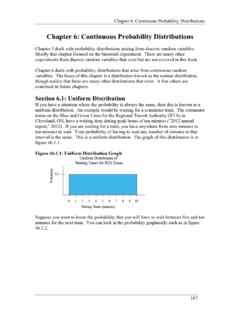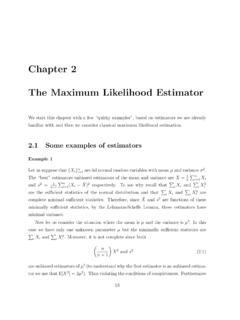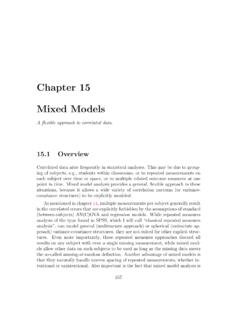Transcription of CHAPTER 23 Question Answering - Stanford University
1 Speech and Language Processing. Daniel Jurafsky & James H. Martin. Copyright 2021. All rights reserved. Draft of December 29, 2021. CHAPTER . Question Answering 23. The quest for knowledge is deeply human, and so it is not surprising that practi- cally as soon as there were computers we were asking them questions. By the early 1960s, systems used the two major paradigms of Question Answering information- retrieval-based and knowledge-based to answer questions about baseball statis- tics or scientific facts. Even imaginary computers got into the act. Deep Thought, the computer that Douglas Adams invented in The Hitchhiker's Guide to the Galaxy, managed to answer the Ultimate Question Of Life, The Universe, and Everything .1. In 2011, IBM's Watson Question - Answering system won the TV game-show Jeop- ardy!, surpassing humans at Answering questions like: WILLIAM WILKINSON'S AN ACCOUNT OF THE. PRINCIPALITIES OF WALLACHIA AND MOLDOVIA . INSPIRED THIS AUTHOR'S MOST FAMOUS NOVEL 2.
2 Question Answering systems are designed to fill human information needs that might arise in situations like talking to a virtual assistant, interacting with a search engine, or querying a database. Most Question Answering systems focus on a par- ticular subset of these information needs: factoid questions, questions that can be answered with simple facts expressed in short texts, like the following: ( ) Where is the Louvre Museum located? ( ) What is the average age of the onset of autism? In this CHAPTER we describe the two major paradigms for factoid Question answer- ing. Information-retrieval (IR) based QA, sometimes called open domain QA, relies on the vast amount of text on the web or in collections of scientific papers like PubMed. Given a user Question , information retrieval is used to find relevant passages. Then neural reading comprehension algorithms read these retrieved pas- sages and draw an answer directly from spans of text. In the second paradigm, knowledge-based Question Answering , a system in- stead builds a semantic representation of the query, such as mapping What states bor- der Texas?
3 To the logical representation: (x) borders(x,texas), or When was Ada Lovelace born? to the gapped relation: birth-year (Ada Lovelace, ?x). These meaning representations are then used to query databases of facts. We'll also briefly discuss two other QA paradigms. We'll see how to query a language model directly to answer a Question , relying on the fact that huge pretrained language models have already encoded a lot of factoids. And we'll sketch classic pre-neural hybrid Question - Answering algorithms that combine information from IR- based and knowledge-based sources. We'll explore the possibilities and limitations of all these approaches, along the way also introducing two technologies that are key for Question Answering but also 1 The answer was 42, but unfortunately the details of the Question were never revealed. 2 The answer, of course, is Who is Bram Stoker', and the novel was Dracula. 2 C HAPTER 23 Q UESTION A NSWERING. relevant throughout NLP: information retrieval (a key component of IR-based QA).
4 And entity linking (similarly key for knowledge-based QA). We'll start in the next section by introducing the task of information retrieval. The focus of this CHAPTER is factoid Question Answering , but there are many other QA tasks the interested reader could pursue, including long-form Question Answering ( Answering questions like why questions that require generating long answers), community Question Answering , (using datasets of community-created Question -answer pairs like Quora or Stack Overflow), or even Answering questions on human exams like the New York Regents Science Exam (Clark et al., 2019) as an NLP/AI benchmark to measure progress in the field. Information Retrieval information Information retrieval or IR is the name of the field encompassing the retrieval of all retrieval IR manner of media based on user information needs. The resulting IR system is often called a search engine. Our goal in this section is to give a sufficient overview of IR.
5 To see its application to Question Answering . Readers with more interest specifically in information retrieval should see the Historical Notes section at the end of the CHAPTER and textbooks like Manning et al. (2008). ad hoc retrieval The IR task we consider is called ad hoc retrieval, in which a user poses a query to a retrieval system, which then returns an ordered set of documents from document some collection. A document refers to whatever unit of text the system indexes and retrieves (web pages, scientific papers, news articles, or even shorter passages like collection paragraphs). A collection refers to a set of documents being used to satisfy user term requests. A term refers to a word in a collection, but it may also include phrases. query Finally, a query represents a user's information need expressed as a set of terms. The high-level architecture of an ad hoc retrieval engine is shown in Fig. Document Inverted Document Document Indexing Document Document Index Document Document Document Document Document Document document collection Search Ranked Document Documents Query query query Processing vector Figure The architecture of an ad hoc IR system.
6 The basic IR architecture uses the vector space model we introduced in Chap- ter 6, in which we map queries and document to vectors based on unigram word counts, and use the cosine similarity between the vectors to rank potential documents (Salton, 1971). This is thus an example of the bag-of-words model introduced in CHAPTER 4, since words are considered independently of their positions. Term weighting and document scoring Let's look at the details of how the match between a document and query is scored. I NFORMATION R ETRIEVAL 3. term weight We don't use raw word counts in IR, instead computing a term weight for each document word. Two term weighting schemes are common: the tf-idf weighting BM25 introduced in CHAPTER 6, and a slightly more powerful variant called BM25. We'll reintroduce tf-idf here so readers don't need to look back at CHAPTER 6. Tf-idf (the -' here is a hyphen, not a minus sign) is the product of two terms, the term frequency tf and the indirect document frequency idf.
7 The term frequency tells us how frequent the word is; words that occur more often in a document are likely to be informative about the document's contents. We usually use the log10 of the word frequency, rather than the raw count. The intuition is that a word appearing 100 times in a document doesn't make that word 100 times more likely to be relevant to the meaning of the document. Because we can't take the log of 0, we normally add 1 to the count:3. tft, d = log10 (count(t, d) + 1) ( ). If we use log weighting, terms which occur 0 times in a document would have tf = log10 (1) = 0, 10 times in a document tf = log10 (11) = , 100 times tf =. log10 (101) = , 1000 times tf = , and so on. The document frequency dft of a term t is the number of documents it oc- curs in. Terms that occur in only a few documents are useful for discriminating those documents from the rest of the collection; terms that occur across the entire collection aren't as helpful. The inverse document frequency or idf term weight (Sparck Jones, 1972) is defined as: N.
8 Idft = log10 ( ). dft where N is the total number of documents in the collection, and dft is the number of documents in which term t occurs. The fewer documents in which a term occurs, the higher this weight; the lowest weight of 0 is assigned to terms that occur in every document. Here are some idf values for some words in the corpus of Shakespeare plays, ranging from extremely informative words that occur in only one play like Romeo, to those that occur in a few like salad or Falstaff, to those that are very common like fool or so common as to be completely non-discriminative since they occur in all 37. plays like good or Word df idf Romeo 1 salad 2 Falstaff 4 forest 12 battle 21 wit 34 fool 36 good 37 0. sweet 37 0.. 3 1 + log10 count(t, d) if count(t, d) > 0. Or we can use this alternative: tft, d =. 0 otherwise 4 Sweet was one of Shakespeare's favorite adjectives, a fact probably related to the increased use of sugar in European recipes around the turn of the 16th century (Jurafsky, 2014, p.)
9 175). 4 C HAPTER 23 Q UESTION A NSWERING. The tf-idf value for word t in document d is then the product of term frequency tft, d and IDF: tf-idf(t, d) = tft, d idft ( ). Document Scoring We score document d by the cosine of its vector d with the query vector q: q d score(q, d) = cos(q, d) = ( ). |q||d|. Another way to think of the cosine computation is as the dot product of unit vectors;. we first normalize both the query and document vector to unit vectors, by dividing by their lengths, and then take the dot product: q d score(q, d) = cos(q, d) = ( ). |q| |d|. We can spell out Eq. , using the tf-idf values and spelling out the dot product as a sum of products: X tf-idf(t, q) tf-idf(t, d). score(q, d) = qP qP ( ). 2 2. t q qi q tf-idf (qi , q) di d tf-idf (di , d). In practice, it's common to approximate Eq. by simplifying the query pro- cessing. Queries are usually very short, so each query word is likely to have a count of 1. And the cosine normalization for the query (the division by |q|) will be the same for all documents, so won't change the ranking between any two documents Di and D j So we generally use the following simple score for a document d given a query q: X tf-idf(t, d).
10 Score(q, d) = ( ). t q |d|. Let's walk through an example of a tiny query against a collection of 4 nano doc- uments, computing tf-idf values and seeing the rank of the documents. We'll assume all words in the following query and documents are downcased and punctuation is removed: Query: sweet love Doc 1: Sweet sweet nurse! Love? Doc 2: Sweet sorrow Doc 3: How sweet is love? Doc 4: Nurse! Fig. shows the computation of the tf-idf values and the document vector length |d| for the first two documents using Eq. , Eq. , and Eq. (com- putations for documents 3 and 4 are left as an exercise for the reader). Fig. shows the scores of the 4 documents, reranked according to Eq. The ranking follows intuitively from the vector space model. Document 1, which has both terms including two instances of sweet, is the highest ranked, above document 3 which has a larger length |d| in the denominator, and also a smaller tf for sweet. Document 3 is missing one of the terms, and Document 4 is missing both.
















